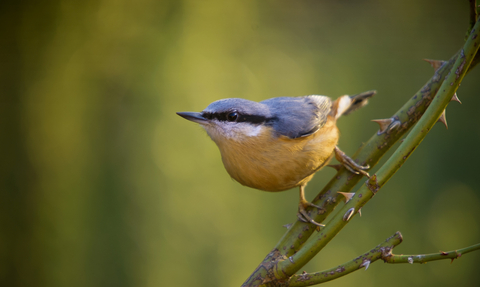
Neil Aldridge
Day 3: Woodland Birds
Welcome to day 3
Today we're going to learn about three of the fascinating birds you might spot in Dorset's woodlands this spring. You'll find out how to identify each bird by sight and sound, so you'll be well-prepared to spot them in the wild. Woodland habitats can be found across the county, from nature reserves like Bracketts Coppice in the north west, to Kilwood and Ashley Wood further south.
Nuthatch
Sitta europaea
Statistics
Length: 14cm
Wingspan: 24cm
Weight: 24g
Average lifespan: 2 years
How to identify
The nuthatch is grey above, with a long, black eyestripe, white cheeks and throat, and a rust-coloured belly.
Did you know?
Nuthatches are the only UK bird that can climb headfirst down tree trunks, holding on with their powerful toes.
Blackcap
Sylvia atricapilla
Statistics
Length: 13-14cm
Wingspan: 22cm
Weight: 21g
Average lifespan: 2 years
How to identify
The blackcap is dark grey; males sport the black cap they are named after, while females and juveniles have a gingery-brown cap. Blackcaps from central Europe are increasingly starting to overwinter in the UK, instead of going back to Africa.
Did you know?
Blackcaps are known as the 'nightingale of the north' because of their beautiful song.
Treecreeper
Certhia familiaris
Statistics
Length: 12-13cm
Wingspan: 19cm
Weight: 10g
Average lifespan: 2 years
How to identify
The treecreeper is white below and mottled brown above, helping it camouflage against the bark of trees. It has a white eyestripe and a long, downcurved bill.
Did you know?
Treecreepers always climb upwards on a trunk, often spiraling around the tree as they go. When they reach the top, they fly to the bottom of a new tree and start again. It's thought this could be an adaptation to save energy, as flying from a high point to a low point takes less effort than level flight.







